In late October 2004, steam
locomotive
3751, retired from the Santa Fe
Railway, was run to San Pedro California from its home in Los Angeles
for an educational outreach program sponsored by the San Bernardino
Railroad Historical Society, the Port of Los Angeles and the Los
Angeles Unified School District. During this successful event 3
day
event, over 400 elementary school students toured the train and
received lessons in safety, history, science and geography. The
train
layed over for a total of 5 days, the last two days open to the public.
Photo by Richard
Elgenson
The train was composed of the vintage
1927 Baldwin Locomotive Works Santa Fe 3751, a 4-8-4 wheel arrangement,
the SBRHS Railway Express baggage
tool car, the newly restored sleeper car Pacific Sands, ex-Southern Pacific
lounge car Overland Trail,
and ex-Canadian Pacific Royal Canadian Mounted Police stock car Pony Express.
The train was run from Amtrak's Redondo roundhouse through the Alameda
Corridor and finally onto the Pacific Harbor Line in the Port of Los
Angeles. It was parked at Harbor Boulevard and 6th Street, just
across
from the Los Angeles Maritime Museum.
Photo by Richard Elgenson
Photo by Richard Elgenson
The educational outreach program was
staffed by volunteers from the San Bernardino Railroad Historical
Society, Operation Lifesaver and the private railroad car owners.
The school children arrived by various means including walking and
bus. Students were directed to the last car of the train, Pony
Express, where they received a presentation by a member of Operation
Lifesaver regarding highway-rail grade crossing safety.
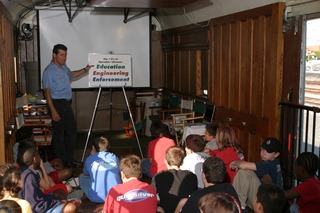
Photo by Steve Crise
Pony Express was built in 1941 in Montreal Canada as a baggage/express
car with beautifully curved sides. It is an open car and up to two
school
classes could be
seated on the floor. After the half hour Operation Lifesaver
segment, volunteer Nancy Fengler, used a laptop computer and projector
for a lesson on modern railroads, including types of trains and local
railroad companies.
The differences were explained between long distance and commuter
passenger trains, and also the different types of freight trains such
as general freight and specialized container intermodal trains.
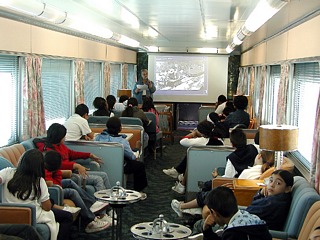
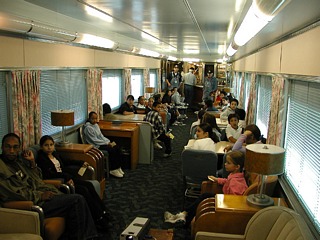
Next, the class was moved into the next car forward, Overland Trail, a
vintage 1949 lounge car with the only operating barber shop in the
country. In the 39 seat Streamline Moderne main salon, Betty
Campbell delivered a history lesson about the
development of the United States through the expansion of the railroads
and the transcontinental railroad which opened up the West. One
interesting fact in this segment was the use of railroads during the U.
S. civil war. The great locomotive chase was covered as well as
the ceremony at Promontory Point. The Overland Trail crew was
dressed in 1950's uniforms as Conductor and
Stewardess.
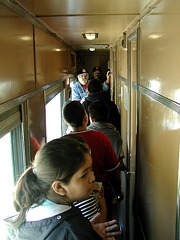
The classess were
then split up into smaller groups
and taken into the Pacific Sands sleeper car to find
out how travel was done in the past before mass airline travel.
The SBRHS volunteers took the children through the sleeper and and
explained the
different levels of accomodations and service. The Pacific Sands
contains six double
bedrooms convertable to 2 room suites and ten single
occupancy roomettes. The students were amazed by the smart
design of the sleeping compartment which were shown
in daytime and
nighttime configurations.
The next educational location was on to a platform to view the steam
locomotive cab and also to a tent outside the locomotive to get a
lesson in science. SBRHS engineers and volunteers explained the
operation of the steam locomotive cab. Steam locomotives are
complicated to operate compared to modern diesel-electric
locomotives. They were also extremely labor intensive for
maintenance. Even though some modern railroads employ a fireman,
he has
no fire to control. The 3751, once a coal burner was converted by
the Santa Fe to consume bunker oil. There are many gauges and
sight
tubes for liquids. The steam locomotive engineer had a very small
window in front of him and an openable window to his right. They
did not have great sight forward with 40 feet of locomotive ahead of
him. At the science table, Wolf Fengler explained the difference
between
base and acid solutions to the students. This is important in the
operation of a
steam locomotive boiler. Water must be kept at the proper ph
level to avoid corrosion of the boiler interior and other steam pipes
in the boiler. Steam locomotives had such safety concerns as
running low on water which could cause a boiler explosion. A flat
driver wheel was a lenthy process to remove and replace. Modern
diesel shops have drop pits to remove and replace traction motors and
wheel sets.
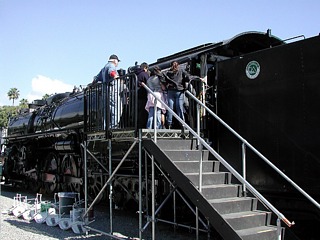
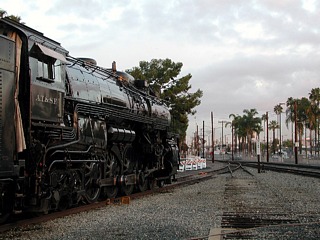
On their way out of the SBRHS educational outreach event, students were
given handouts from Operation Lifesaver including pencils, bookmarks,
bracelets and saftey literature.
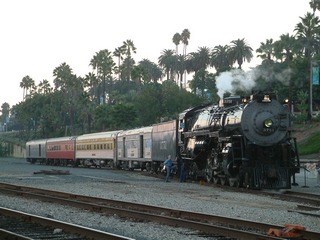
Photo by Richard Elgenson
Email me: Richard@TrainWeb.com
